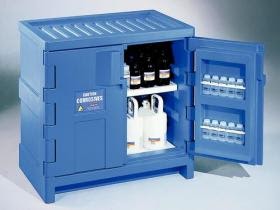Corrosive Substances
Many chemicals commonly used in the laboratory are corrosive or irritating to body tissue. They present a hazard to the eyes and skin by direct contact, to the respiratory tract by inhalation or to the gastrointestinal system by ingestion.
Safe Handling
Corrosive Liquids
Corrosive liquids (e.g. mineral acids, alkali solutions and some oxidizers) represent a very significant hazard because skin or eye contact can readily occur from splashes and their effect on human tissue generally takes place very rapidly. Bromine, sodium hydroxide, sulfuric acid and hydrogen peroxide are examples of highly corrosive liquids. See Chemical-Specific Protocols for specific corrosive liquids such as Hydrofluoric Acid and Phenol.
The following should be considered:
- The eyes are particularly vulnerable. It is therefore essential that approved eye and face protection be worn in all laboratories where corrosive chemicals are handled.
- Gloves and other chemically resistant protective clothing should be worn to protect against skin contact.
- To avoid a flash steam explosion due to the large amount of heat evolved, always add acids or bases to water (and not the reverse).
- Acids and bases must be segregated for storage.
- Liquid corrosives should be stored below eye level.
- Adequate quantities of spill control materials should be readily available. Specialized spill kits for acids and bases are available through most chemical and laboratory safety supply catalogs.
Corrosive Gases and Vapors
Corrosive gases and vapors are hazardous to all parts of the body; certain organs (e.g. the eyes and the respiratory tract) are particularly sensitive. The magnitude of the effect is related to the solubility of the material in the body fluids. Highly soluble gases (e.g. ammonia, hydrogen chloride) cause severe nose and throat irritation, while substances of lower solubility (e.g. nitrogen dioxide, phosgene, sulfur dioxide) can penetrate deep into the lungs.
- Warning properties such as odor or eye, nose or respiratory tract irritation may be inadequate with some substances. Therefore, they should not be relied upon as a warning of overexposure.
- Perform manipulations of materials that pose an inhalation hazard in a chemical fume hood to control exposure or wear appropriate respiratory protection.
- Protect all exposed skin surfaces from contact with corrosive or irritating gases and vapors.
- Regulators and valves should be closed when the cylinder is not in use and flushed with dry air or nitrogen after use.
- When corrosive gases are to be discharged into a liquid, a trap, check valve, or vacuum break device should be employed to prevent dangerous reverse flow.
Corrosive Solids
Corrosive solids, such as sodium hydroxide and phenol, can cause burns to the skin and eyes. Dust from corrosive solids can be inhaled and cause irritation or burns to the respiratory tract. Many corrosive solids, such as potassium hydroxide and sodium hydroxide, can produce considerable heat when dissolved in water.
- Wear gloves and eye protection when handling corrosive solids.
- When mixing with water, always slowly add the corrosive solid to water, stirring continuously. Cooling may be necessary.
- If there is a possibility of generating a significant amount of dust, conduct work in a fume hood.
Acid Storage
Mineral acids, including phosphoric, hydrochloric, nitric, sulfuric, and perchloric acid can be stored in a cabinet designed for corrosive acids. Nitric acid can also be stored with oxidizers. These non-metallic cabinets have no internal metallic parts, acid resistant coating and a cabinet floor constructed to be able to contain spillage. Volatile acids, such as oleum or fuming nitric acid, should be stored either in an acid cabinet or in a vented cabinet, such as the fume hood base, particularly after they have been opened. Concentrated mineral acids can be very reactive, even with each other.
Organic acids such as acetic acid should be stored separately from mineral acids. While it is always best to segregate, acetic acid can be stored with other flammable liquids.
Picric acid can form explosive salts with many metals, or by itself when dry. It is incompatible with other storage groups and should be stored separately. Perchloric acid is an extremely powerful oxidizer and must be kept away from all organic materials. It should also be stored separately.


